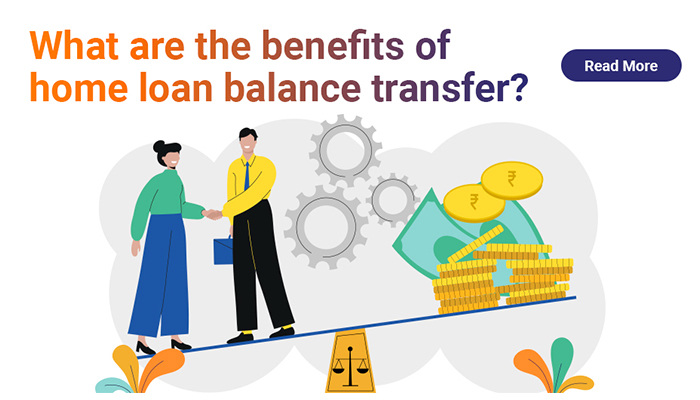Home Loan Balance Transfer - Step By Step Guide

If you are currently repaying a home loan, the balance transfer facility is an excellent way to benefit from cheaper loan offerings of another lender. Read this post for a step-by-step guide on the transfer process.
Over the entire term of home loan repayment, a borrower pays lakhs of rupees in interest to the lender. Even a small difference in the interest rate could help one save a lot of money in the process. While we often find new borrowers searching for the cheapest rates to save more on home loan repayments, what about those already servicing a housing loan?
Existing lenders can also benefit from cheaper loan offerings of another lender by switching or transferring their loan balance. Known as the home loan transfer facility, it can help you save a significant amount of money and access better services of another lender even if you are already repaying a home loan.
Here are the steps you can follow for transferring a home loan-
1. Start with a Cost-Benefit Analysis
Before applying for the transfer, it is essential to ensure that you are actually able to save a significant amount of money by switching to another lender. While you might have selected the new lender by closely analyzing the difference in the interest rate, there are other cost-related aspects that deserve your attention. Switching your loan to another lender is similar to taking a new home loan . So, the new lender will also charge a processing fee for the same. Compare your savings with these expenses to ensure that the deal is highly profitable.
In most cases, it is better to use the balance transfer facility in the first few years of the loan when the interest component is higher in your EMI amount.
2. Inform the Current Lender and Collect the NOC
Once you have finalized a new lender and confirmed the cost-benefit, it is time to inform your current lender about your decision to switch to another lender. It is possible that your current lender might negotiate the rate slightly or offer other benefits to make you stay with them. If you’d still like to switch, you’ll be required to submit an application form for the same.
3. Apply for Balance Transfer with the New Lender
After receiving NOC and other documents, you are ready to begin the balance transfer process with the new lender. Submit all of these documents to the new lender, along with KYC documents, to start the approval process.
It is also possible that the new lender might have slightly different eligibility requirements for a home loan. Confirm the same before you initiate the transfer process. Along with the documents, you’ll also be required to submit a duly filled application form and a processing fee cheque.
4. Wait for Confirmation
The new lender will verify your documents with the old lender before approving your application. After verification, the new lender will credit the outstanding balance to your bank account or directly to the account of the older lender. If you receive the loan amount, you can use it to close your loan with the older lender. You are now ready to sign a new home loan agreement with the new lender. Pay the charges, if any, and you’d have successfully transferred your home loan
Should You Use the Home Loan Balance Transfer Facility?
As discussed above, it is generally recommended that borrowers use the balance transfer facility in the first few years of the loan for maximum savings. But if you’ve already repaid the loan for 10-12 years, the savings might not be very significant.
Ensure that you thoroughly compare the terms and conditions of both the lenders and perform a cost-benefit analysis to make the right decision. Some of the lenders also have balance transfer calculators on their websites to help you know the exact amount you can save by switching to the new lender.
Give special attention to all the additional costs you’ll be required to pay to the old and new lenders, as they can consume a significant portion of your savings.
Tags
Disclaimer: The information contained in this post is for general information purposes only. IIFL Home Finance Limited (including its associates and affiliates) ("the Company") assumes no liability or responsibility for any errors or omissions in the contents of this post and under no circumstances shall the Company be liable for any damage, loss, injury or disappointment, etc. suffered by any reader. All information in this post is provided "as is", with no guarantee of completeness, accuracy, timeliness, or of the results, etc. obtained from the use of this information, and without warranty of any kind, express or implied, including, but not limited to warranties of performance, merchantability, and fitness for a particular purpose. Given the changing nature of laws, rules, and regulations, there may be delays, omissions, or inaccuracies in the information contained in this post. The information on this post is provided with the understanding that the Company is not herein engaged in rendering legal, accounting, tax, or other professional advice and services. As such, it should not be used as a substitute for consultation with professional accounting, tax, legal or other competent advisers. This post may contain views and opinions which are those of the authors and do not necessarily reflect the official policy or position of any other agency or organization. This post may also contain links to external websites that are not provided or maintained by or in any way affiliated with the Company and the Company does not guarantee the accuracy, relevance, timeliness, or completeness of any information on these external websites. Any/ all (Home/ Loan Against Property/ Secured Business Loan/ Balance Transfer/ Home Improvement Loan/ NRI Home Loan/ Home Loan for Uniformed Services) loan product specifications and information that may be stated in this post are subject to change from time to time, readers are advised to reach out to the Company for current specifications of the said (Home/ Loan Against Property/ Secured Business Loan/ Balance Transfer/ Home Improvement Loan/ NRI Home Loan/ Home Loan for Uniformed Services) loan.
 Login
Login






















